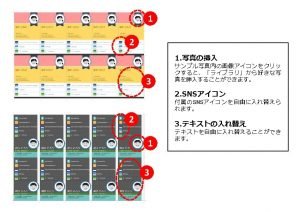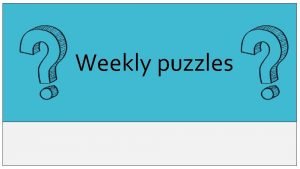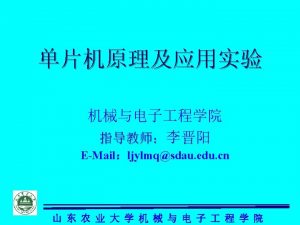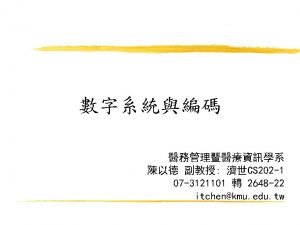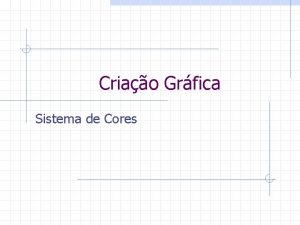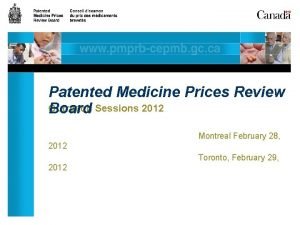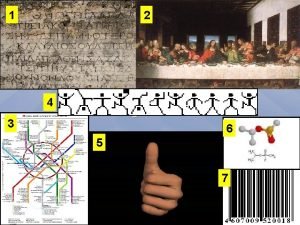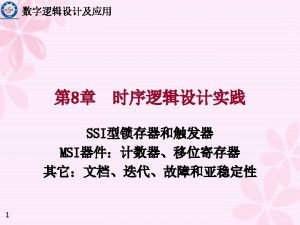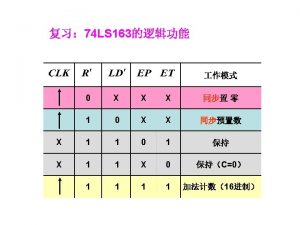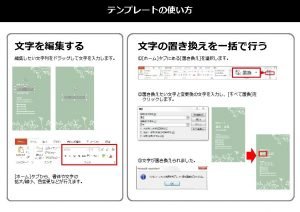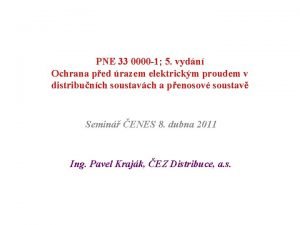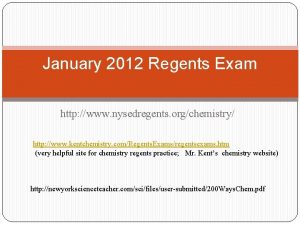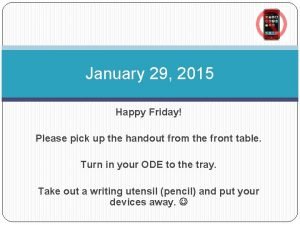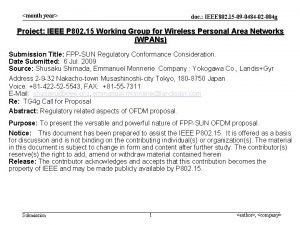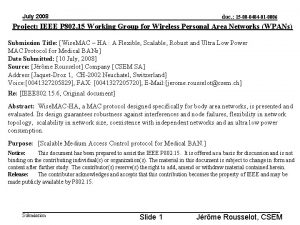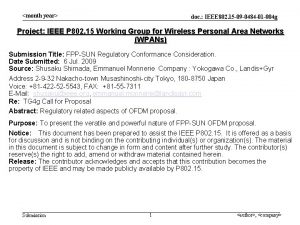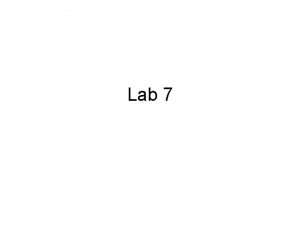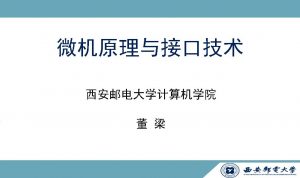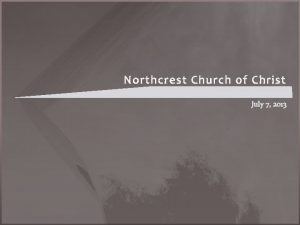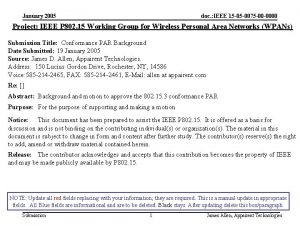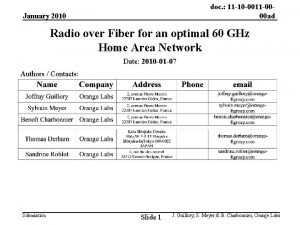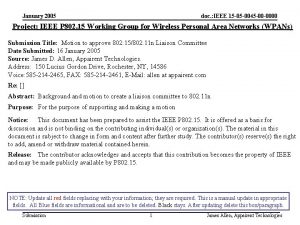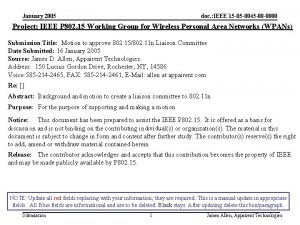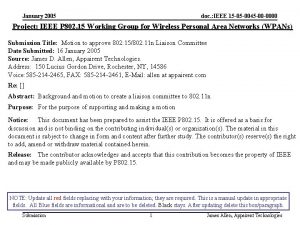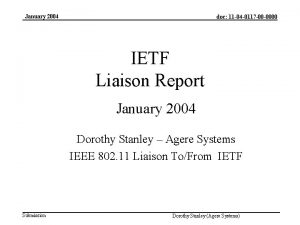January 2014 doc 15 11 0484 03 0000



















- Slides: 19

<January 2014> doc. : <15 -11 -0484 -03 -0000> Project: IEEE P 802. 15 Working Group for Wireless Personal Area Networks (WPANs) Submission Title: [TG 4 e Overview] Date Submitted: [18 Jan 2014] Source: [Patrick Kinney] Company [Kinney Consulting LLC] Address [Chicago area, IL, USA] Voice: [+1. 847. 960. 3715], E-Mail: [pat. kinney@ieee. org] Re: [Information on TG 4 e for Jan 2014 Session] Abstract: [Information on TG 4 e for Jan 2014 Session] Purpose: [To assist in the understanding of TG 4 e] Notice: This document has been prepared to assist the IEEE P 802. 15. It is offered as a basis for discussion and is not binding on the contributing individual(s) or organization(s). The material in this document is subject to change in form and content after further study. The contributor(s) reserve(s) the right to add, amend or withdraw material contained herein. Release: The contributor acknowledges and accepts that this contribution becomes the property of IEEE and may be made publicly available by P 802. 15. Submission Slide 1 <Pat Kinney>, <Kinney Consulting LLC>

<January 2014> doc. : <15 -11 -0484 -03 -0000> TG 4 e • First MAC amendment to 802. 15. 4 • Originally intended to amend 802. 15. 4 -2006 but changed to amend 802. 15. 4 -2011 to: • better support the industrial markets, and • permit compatibility with modifications proposed within the Chinese WPAN • Changes to address TG 4 f • Changes to address TG 4 g Submission Slide 2 <Pat Kinney>, <Kinney Consulting LLC>

<January 2014> doc. : <15 -11 -0484 -03 -0000> TG 4 e major changes • Deterministic & Synchronous Multi-channel Extension mode • Time Slotted Channel Hopping mode • Low Latency Deterministic Network mode • Additional Frame Formats • Low Energy mode • Enhanced Beacon behavior • Information Elements • Miscellaneous Submission Slide 3 <Pat Kinney>, <Kinney Consulting LLC>

<January 2014> doc. : <15 -11 -0484 -03 -0000> Deterministic & Synchronous Multichannel Extension (DSME) • Support of industrial applications and commercial applications which need deterministic latency and higher link reliability • Operation – DSME-enabled network runs on beacon-enabled PAN. All devices synchronize multi-superframe via beacon frame. – Multi-superframe enhances GTS operation in 802. 15. 4 -2006 by grouping multiple superframes, and also extends single channel operation during CFP to multi-channel operation either by adapting (switching) channels or by hopping channels. – A pair of peer devices wakes up at a reserved GTS slot(s) to exchange a data frame and an ACK frame. Submission Slide 4 <Pat Kinney>, <Kinney Consulting LLC>

<January 2014> doc. : <15 -11 -0484 -03 -0000> Time Slotted Channel Hopping (TSCH) • Process Automation applications with a particular focus on equipment and process monitoring • Operation – – All devices in the same network synchronize slotframes All timeslots are contained within a slotframe cycle Timeslots repeat in time: the slotframe period Device-to-device communication within a timeslot includes packet Tx/Rx & ACK Tx/Rx Submission Slide 5 <Pat Kinney>, <Kinney Consulting LLC>

<January 2014> doc. : <15 -11 -0484 -03 -0000> Time Slotted Channel Hopping (TSCH) Typical segments of the application domain of TSCH are process automation facilities for the following: • Oil and gas industry • Food and beverage products • Chemical products • Pharmaceutical products • Water/waste water treatments Submission Slide 6 <Pat Kinney>, <Kinney Consulting LLC>

<January 2014> doc. : <15 -11 -0484 -03 -0000> Time Slotted Channel Hopping (TSCH) TSCH mode overview • The TSCH mode uses time synchronized communication and channel hopping to provide network robustness through spectral and temporal redundancy. Time slotted communication links increase potential throughput by minimizing unwanted collisions that can lead to catastrophic failure and provides deterministic yet flexible bandwidth for a wide variety of applications. Channel hopping extends the effective range of communications by mitigating the effects of multipath fading and interference. TSCH is also topology independent; it can be used to form any topology from a star to a full mesh. TSCH MAC primitives can be used with higher layer networking protocols to form the basis of reliable, scalable, and flexible networks. Submission Slide 7 <Pat Kinney>, <Kinney Consulting LLC>

<January 2014> doc. : <15 -11 -0484 -03 -0000> Time Slotted Channel Hopping (TSCH) MAC behaviors unique to TSCH • The TSCH mode introduces no unique commands specific for this mode; however, IEs are used extensively. • TSCH uses EBs containing the TSCH Synchronization payload IE, TSCH-Slotframe and Link payload IE, TSCH Timeslot payload IE, and Channel Hopping payload IE to advertise the presence of a TSCH PAN and allow new devices to synchronize to it. Devices maintain synchronization by exchanging acknowledged frames within defined Timeslot windows and providing timing corrections in the acknowledgment via the ACK/NACK Time Correction IE. Communication resources are broken up into timeslots that are organized into repeating slotframes Submission Slide 8 <Pat Kinney>, <Kinney Consulting LLC>

<January 2014> doc. : <15 -11 -0484 -03 -0000> Time Slotted Channel Hopping (TSCH) TSCH areas within the 802. 15. 4 e amendment • The. TSCH-Slotframe structure behavior is cited in 5. 1. 1. 5, synchronization is stated in 5. 1. 1. 4, the IEs are described in 5. 2. 4. 11, 5. 2. 4. 13, 5. 2. 4. 14, 5. 2. 4. 15, and the primitives are declared in 6. 2. 19. TSCH link example • Figure on next slide shows how nodes may communicate in a very simple three-timeslotframe. Submission Slide 9 <Pat Kinney>, <Kinney Consulting LLC>

<January 2014> doc. : <15 -11 -0484 -03 -0000> Time Slotted Channel Hopping (TSCH) Nodes A and B communicate during timeslot 0, nodes B and C communicate during timeslot 1, and timeslot 2 is not being used. Every three timeslots, the schedule repeats, but note that ASN increments continuously. The pairwise assignment of a directed communication between devices in a given timeslot on a given channel. Offset is a link. Submission Slide 10 <Pat Kinney>, <Kinney Consulting LLC>

<January 2014> doc. : <15 -11 -0484 -03 -0000> Time Slotted Channel Hopping (TSCH) • Physical channel, CH, in a link is made according to the following formula: – CH = mac. Hopping. Sequence. List [(mac. ASN + channel. Offset) % mac. Hopping. Sequence. Length] • Use of a channel. Offset allows for different channels to be used at a given mac. ASN for a given mac. Hopping. Sequence. List. There are mac. Number. Of. Channels channel. Offsets that will result in a unique channel for that combination of mac. ASN and mac. Hopping. Sequence. List. Submission Slide 11 <Pat Kinney>, <Kinney Consulting LLC>

<January 2014> doc. : <15 -11 -0484 -03 -0000> Low Latency Deterministic Network (LLDN) • Support of factory automation and process automation e. g. automotive robots/suspension tracks, machine tools milling/turning/robot revolver • Uses beacon and assigned time slots to provide determinism • Designed for small networks and small frames • Substantial reduction in MAC overhead to allow very small superframes, hence reduced device latencies • Includes a Group ACK function to reduce bandwidth needs Submission Slide 12 <Pat Kinney>, <Kinney Consulting LLC>

<January 2014> doc. : <15 -11 -0484 -03 -0000> Additional Frame Formats • New frame type to accommodate LLDN networks – Reduced overhead • Added multipurpose frame that: – Accommodates TG 4 f (Tx only devices), Low Energy mode, etc. – Reduce overhead, e. g. MAC overhead for an TG 4 f type frame can be as low as 4 octets (MAC overhead was 11 octets with the previous frame type) – Provides configurability and extensibility Submission Slide 13 <Pat Kinney>, <Kinney Consulting LLC>

<January 2014> doc. : <15 -11 -0484 -03 -0000> Low Energy • IP-centric Sensor Networks – Creates illusion of Always On, Low Latency, Multicast Capable, Synchronous Acks • Coordinated Sampled Listening (CSL) – Receiver periodically performs channel sampling for radio traffic • – Sender transmits wakeup frame sequence prior to payload frame • • – Every mac. CSLPeriod (ms) Full wakeup sequence (mac. CSLMax. Period) if unsynchronized with receiver, i. e. , first time to send to the receiver Short wakeup sequence for guard time if synchronized with receiver Tradeoff between latency and energy consumption • Receiver Initiated Transmission (RIT) – Receiver periodically broadcasts datareq frames and listen for a short amount of time (mac. Rit. Data. Wait. Period) for incoming transmissions every mac. Rit. Period – Sender waits until receiving datareq frame from receiver then immediately transmit payload frame – Works better when higher latency can be tolerated and works with regulations which limit continuous transmission duration (e. g. , Japan) Submission Slide 14 <Pat Kinney>, <Kinney Consulting LLC>

<January 2014> doc. : <15 -11 -0484 -03 -0000> Enhanced Beacon & Enhanced Beacon Requests • Enhanced beacon includes ability to carry additional information in beacons (IEs). • Enhanced beacon request includes respondent filters and generalized information query capability Submission Slide 15 <Pat Kinney>, <Kinney Consulting LLC>

<January 2014> doc. : <15 -11 -0484 -03 -0000> Information Elements (IEs) • Simple, extensible, flexible information container • Allows adding information to existing frame format without adding new frame type • Managed and unmanaged ID spaces allows flexibility • Already being utilized by TG 4 g and TG 4 f Submission Slide 16 <Pat Kinney>, <Kinney Consulting LLC>

<January 2014> Miscellaneous doc. : <15 -11 -0484 -03 -0000> • Fast Association – This mode allows a device to send association response in direct communication eliminating a delay in the current indirect communication association response command • Network Metrics – Added attributes mac. Retry. Count, mac. Multiple. Retry. Count, mac. TXFail. Count, mac. TXSuccess. Count relate to data frame transmission – Added attributes mac. FCSError. Count, mac. Security. Failure, mac. Duplicate. Frame. Count, mac. RXSuccess. Count relate to data frame reception • Channel Diversity – Provides support for Channel Hopping via Hopping Sequence PIB and a default hopping sequence Submission Slide 17 <Pat Kinney>, <Kinney Consulting LLC>

<January 2014> Miscellaneous doc. : <15 -11 -0484 -03 -0000> • Enhanced Acknowledgement Frames – Allow ACKs be secured, include payloads, and a configurable delay to allow devices sufficient time to decrypt, etc Submission Slide 18 <Pat Kinney>, <Kinney Consulting LLC>

<January 2014> Summary doc. : <15 -11 -0484 -03 -0000> • Substantial additions to enable “managed” networks (such as DSME, TSCH, LLDN) to exhibit deterministic behavior, accommodate a large number of devices, better manage network behaviors • Additional protocol behaviors that can facilitate longer battery life, faster response times, etc Submission Slide 19 <Pat Kinney>, <Kinney Consulting LLC>
 090-0000-0000
090-0000-0000 1752=0 2061=2
1752=0 2061=2 0000llll
0000llll 0000 0001 0010
0000 0001 0010 Codigo rbg
Codigo rbg 952 203-0000
952 203-0000 таблица ansi
таблица ansi 1100 0001
1100 0001 Xxx university
Xxx university Military time current
Military time current 0000 0001
0000 0001 1 000 000 0000
1 000 000 0000 Ochrana polohou živých částí
Ochrana polohou živých částí Bcd addition of 184 and 576
Bcd addition of 184 and 576 Anamnesi ostetrica para 0000
Anamnesi ostetrica para 0000 1st january 2018
1st january 2018 Mozart's grave
Mozart's grave 1995 january 23 nasa
1995 january 23 nasa Kent chemistry reference table
Kent chemistry reference table January 29 2015
January 29 2015
